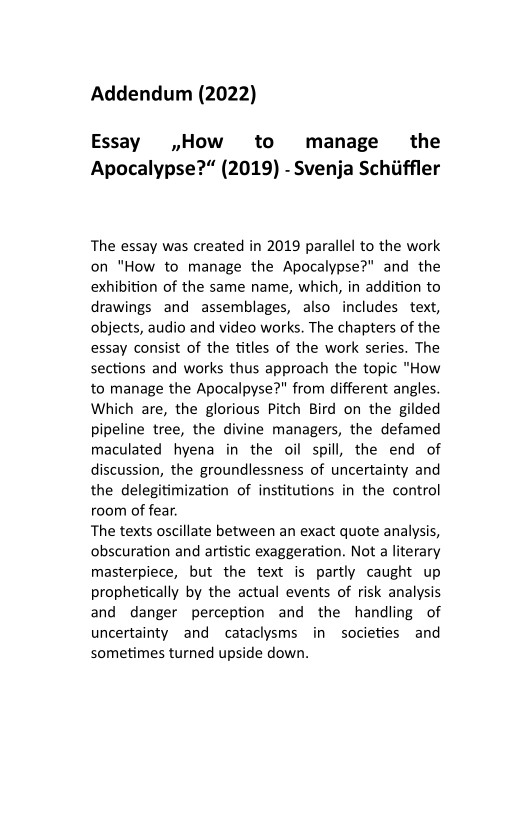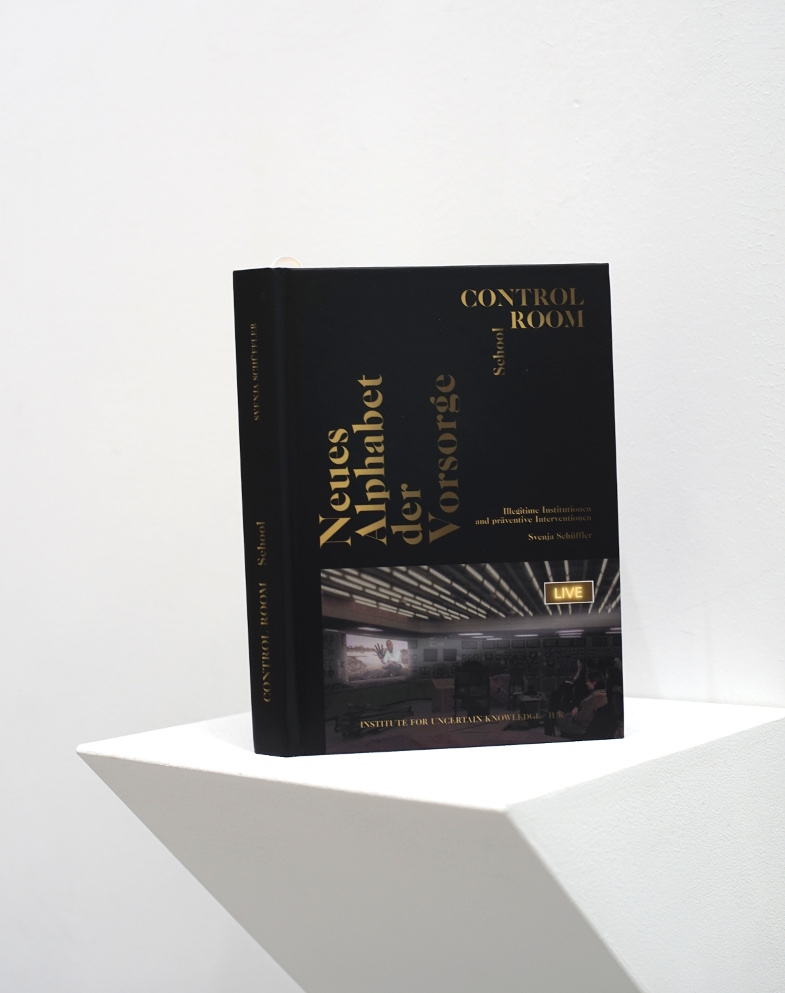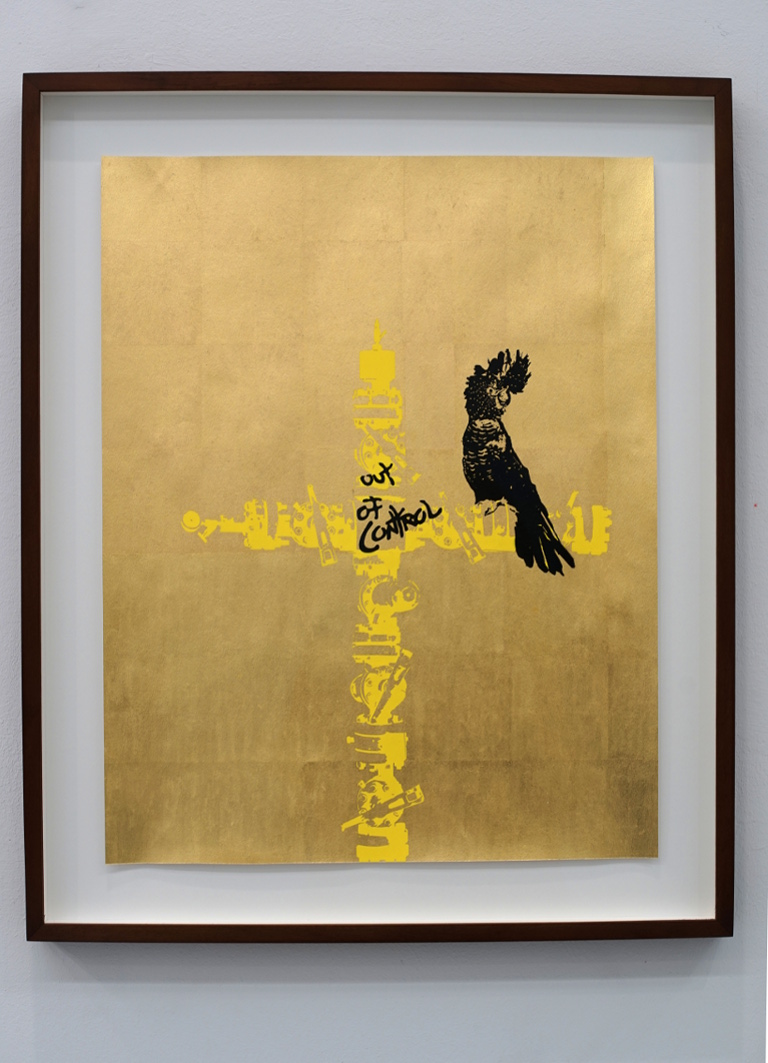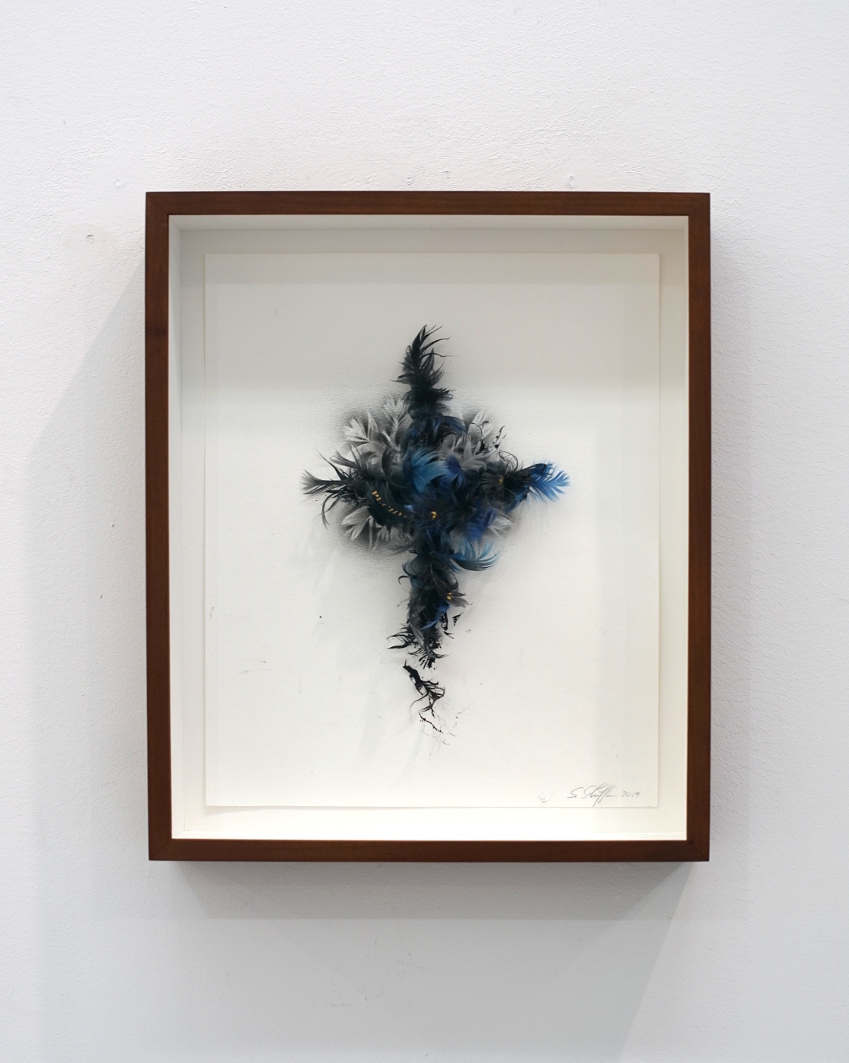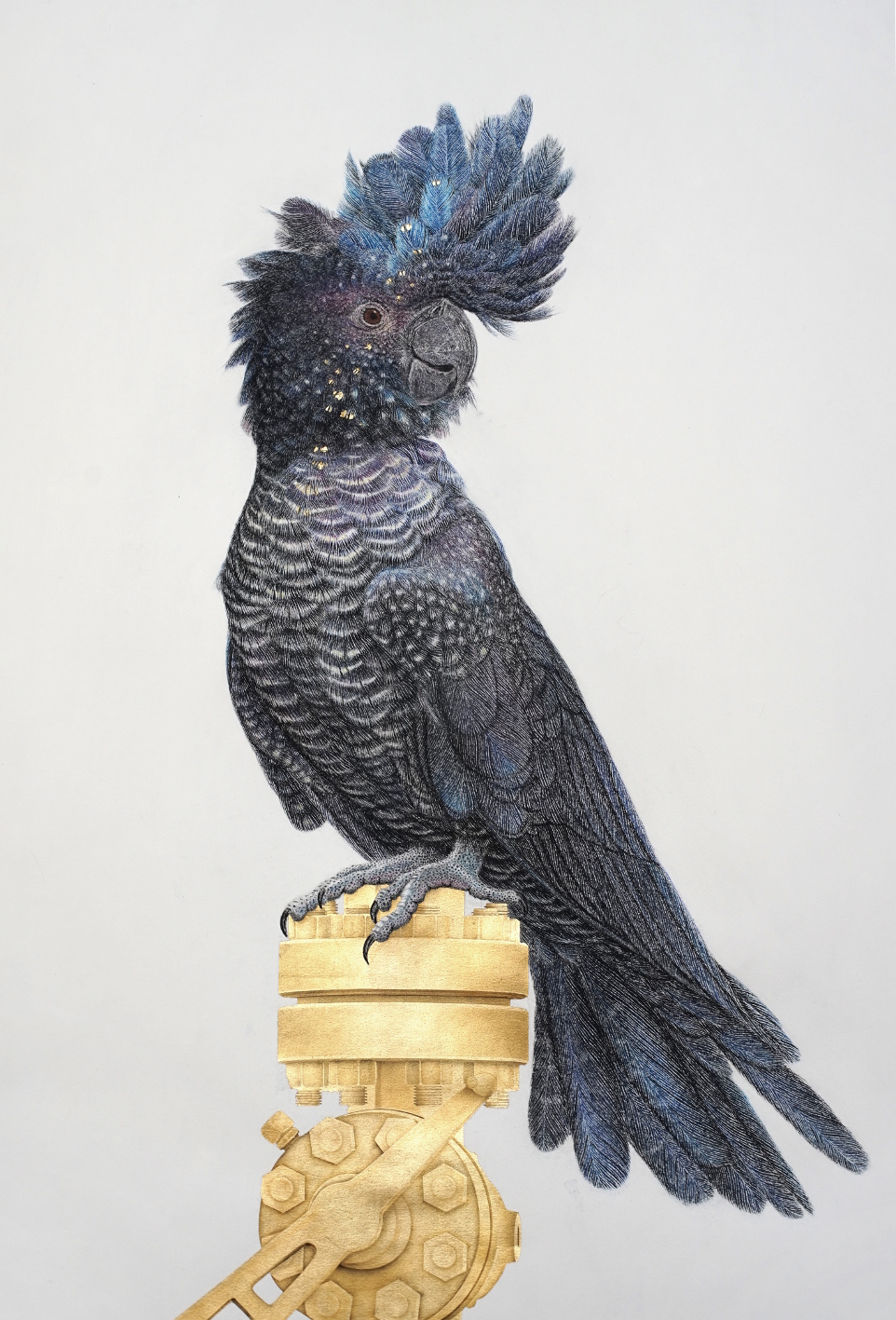
Pitch Bird (2) | 2019 – ‘How to manage the Apocalypse ?’ – Chalk pastels, gold leaf on paper; ink on gold leaf, 95 x 88cm, (Detail: 80 x 60cm)
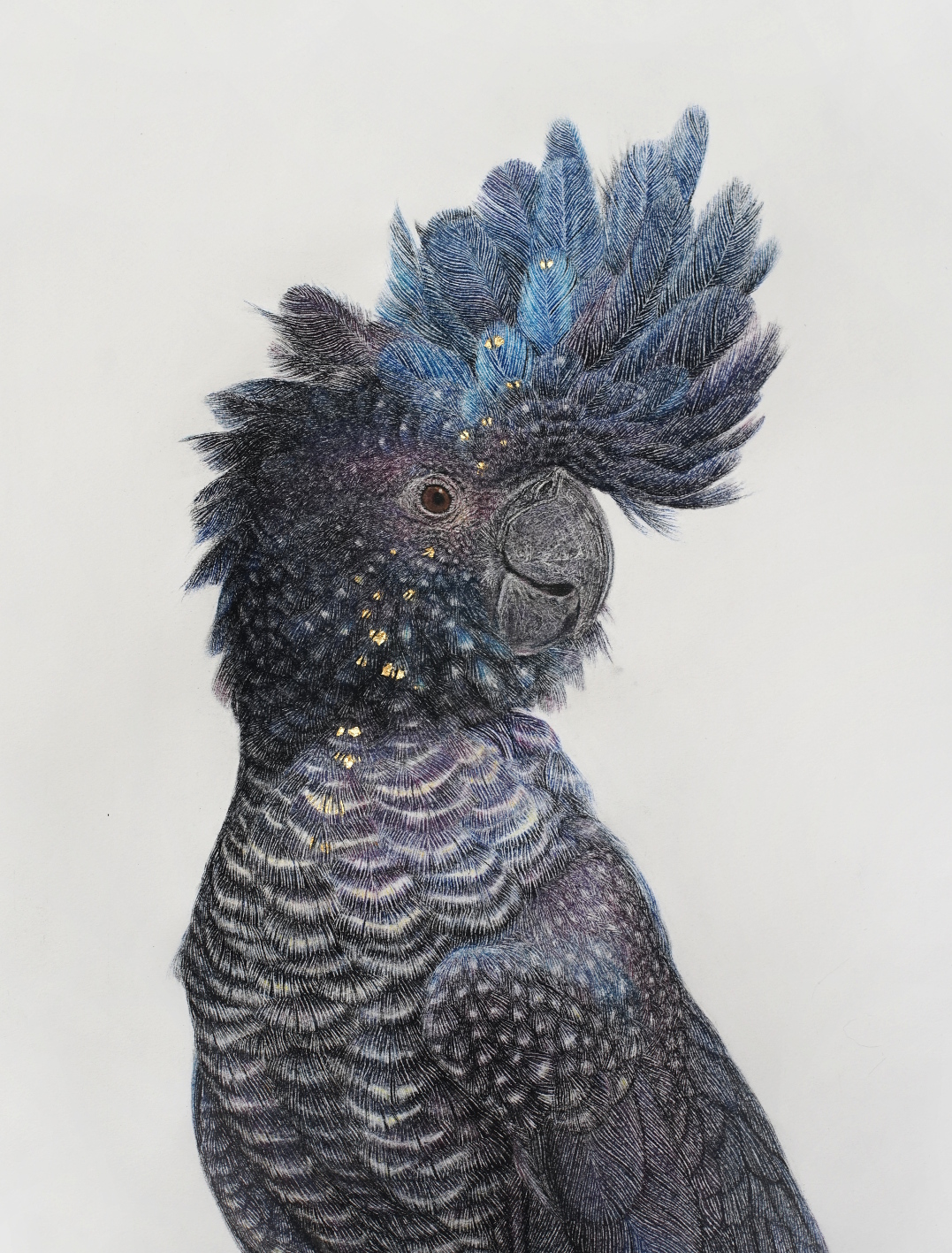
detail
How to manage the Apocalypse?
Essay (DE):
How to manage the Apocalypse?
![]()
(DE)
Die neuen Arbeiten zeigen eine Fülle an grafischen Techniken auf Papier, die speziell für die Werkreihe ausgearbeitet und erweitert wurden. Dabei werden kunsthistorisch sehr alte Techniken wie die Vergoldung, die Frottage-Drucktechnik und eine Papierfärbetechnik mit Ölfarbe verbunden mit zeitgenössischer Airbrush-Schablonierung sowie Zeichnungen in Ritztechnik unter Pastellkreide. Insbesondere die Detailhaftigkeit und Genauigkeit der geritzten Pastellkreide Zeichnungen sind für Svenja Schüfflers Arbeit prägend. Sie sind das Ergebnis wochen- oder monatelanger Arbeit unter der Lupe. Dadurch entstehen eindringliche Studien menschlicher und tierischer Kompositionen. In den neuen Arbeiten wird Schrift und Typographie als gestalterisches Element hinzugefügt, als Kommentar und Überschreibung konzeptualisiert oder als Sinnbild arrangiert.
Die Arbeiten stehen in Korrespondenz mit einem Essay mit dem Titel „How to manage the Apocalypse?“, das als Teil eines Kunstbuchs in der Ausstellung präsentiert wird und als Kopie zum Mitnehmen in der Ausstellung ausliegt. Die Lesarten von Essay und Bildern reflektieren und inspirieren sich jeweils gegenseitig.
Das Projekt geht ästhetisch und literarisch zum einen der Frage nach: „How to manage?“ Oder anders gefragt. In einer maßgeblich durch fossilen Kohlenstoff angetriebenen hochtechnologischen Zivilisation, folgt Management hier nicht folgender verherrlichten Logik?: Sicherung von Energieversorgung und Technologieprojekten muss Vorrang vor den damit verbundenen Nebeneffekten gegeben werden. Und würde das nicht eigentlich bedeuten, dass dem Wesen nach die ungewollten Konsequenzen gar nicht verhindert, stattdessen aber gezielt gesteuert und kontrolliert, das heisst gemanagt werden?
Der Glaube Katastrophen und ungewollte Konsequenzen ließen sich managen scheint keine Grundlage zu haben. Denn die Grenzen der Versicherbarkeit, das heißt das zunehmende Fehlen von Privatversicherung verweist auf nicht mehr kontrollierbare und berechenbare Unsicherheiten und Technologierisiken in globalem Maßstab. Das liefert eine nicht angreifbare Begründung Alarm zu schlagen. „How to manage the Apocalypse?“ nun fragt, wie sich eine neue Art und Weise des Sprechens vom Ende finden lässt, die die Katastrophe an die Wand malt um sie zu verhindern und zu unterlassen? In der Ausstellung und dem Essay wird dieser Frage in einem Gedankenexperiment und der Konzeption einer Schule der Frühwarnung vom Ende aller Versicherung nachgegangen.
In separaten Räumen der Galerie werden mit „An Experiment on a Bird“ 2016 und „Anthropomorpha“ 2013 auch Zeichenprojekte zum Erdbebenrisiko und zur Grenze von Mensch und Tier zu sehen sein. Einige Arbeiten waren gerade in der Kunsthalle Rostock in der Jubiläums-Ausstellung „Experiment Zukunft“ zu sehen, die nun auch in der Galerie Kuchling präsentiert werden. Auch in diesen Projekten werden Fragen zu Unsicherheit aufgegriffen. Die Konfrontation mit und die Erfahrung von Unsicherheit und Unsicherem Wissen in der Wissenschaft, durch das Studium der Geologie und Geoinformationswissenschaften, markieren den Ausgangspunkt für die künstlerische Laufbahn und begründen die thematische Ausrichtung auf Wissenschaft, Technologie und Erde, und die Unsicherheit von Wissen.
Mitgründung des Institute for Uncertain Knowledge (IUK), das sich dem Phänomen des „Unsicheren Wissens“ in Wissenschaft und Gesellschaft künstlerisch widmet und Wissen über Unsicherheit produziert.
2015 Teilnahme am Forecast Forum/HKW. Präsentation einer multimedialen Echtzeitsimulation für das Erdbebenrisiko in Istanbul, unterstützt vom Deutschen GeoForschungsZentrum GFZ in Potsdam.
2016 Teilnahme am Anthropocene Curriculum am HKW.
An Essay on drawings and collages about a management without end, culminating in the design of an insurance – a sort of early warning school signaling the end of all guarantee.
Ein Essay über Zeichnungen und Collagen zum Management ohne Ende, und letztendlich über den Entwurf einer Versicherung, – eine Art Schule der Frühwarnung vom Ende aller Versicherung.
*******************************************************************************
(EN)
Her latest accomplishments show a vast range of graphic techniques on paper that Svenja Schüffler prepared and expanded especially for this work group. With great mastery the artist combines traditional skills like gilding, frottage printing and oil-based paper dye technique with modern techniques like airbrush stencil works and a scratch technique under pastel chalks that she had conceived herself. In terms of their great focus on detail and precision, these scratched pastel chalk drawings are characteristic of Svenja Schüffler‘s artistic creation. They are the result of a meticulous work process with a magnifying glass that may take up to a few weeks or even months. This way extremely striking studies of human and beastly compositions come into existence. To her late works the artist added letters and typography as creative elements, conceiving them as commentary and headers, or arranged in form of allegories.
With regards to content, her works correspond with her essay “How to manage the Apocalypse?“. It will be presented in the exhibition as part of an artist book. Visitors are also invited to take a copy of it home. Different readings of essay and pictures reflect and inspire each other.
Both aesthetically and literarily, the project poses the question: “How to manage?“, and explores whether management in a high-tech civilization significantly fueled by fossil carbon follows this glorifying logic: Safeguarding energy supplies and technology projects takes absolute precedence over the accompanying side effects. Wouldn‘t that mean, that undesired consequences don‘t require prevention but just control, so to speak management?
There seems to be no just basis for a belief that sees disasters and undesired consequences as things that can be managed, because the limits of insurability, that is the increasing lack of private insurance, suggests uncontrollable and incomputable uncertainties and technological risks on a global scale.
A non-contestable justification is generated to raise alarm. “How to manage the Apocalypse?“ investigates into the issue of how a new method of talking about the end is attained, one that names the catastrophe loud, in order to prevent it. Both in the exhibition and in her essay Svenja Schüffler explores this question with a thought experiment and the conception of a ‘School of Early Warning’ that cautions the end of all guarantee.
With “An Experiment on a Bird” (2016) and “Anthropomorpha” (2013) two drawing projects on earthquake risks and the line between man and animal will be showcased in separate gallery rooms.
These projects also reflect the artist‘s approach to questions of uncertainty. Confrontation with and the experience of uncertainty and unsecured knowledge in science that Svenja Schüffler brings with her from her studies of geology and geo-information science, provide the starting point of her artistic career and give direction to her focus on science, technology and the Earth, as well as on the uncertainty of knowledge.
Svenja Schüffler is co-founder of the Institute for Uncertain Knowledge (IUK), which approaches the phenomenon of “Uncertain Knowledge“ in science and society from an artistic angle, and produces knowledge about uncertainty.
With the support of the German Research Centre for Geosciences GFZ in Potsdam, the artist presented a multimedia-based concept of a real-time simulation of the earthquake risk in Istanbul at the Forecast Forum at the Berlin Haus der Kulturen der Welt (“House of the World’s Cultures”) in 2015. In 2016, the artist took also part in the Anthropocene Curriculum at the HKW.
Just a few weeks ago several works by Svenja Schüffler were included in the anniversary exhibition “Experiment Zukunft“ at the Kunsthalle Rostock and will now be on display at Galerie Kuchling. After long-term stays in Cuba and in Spain, Svenja Schüffler has been living and working in Berlin since 2011.
